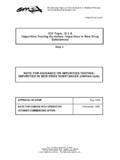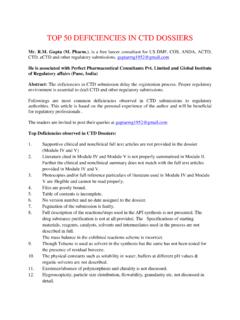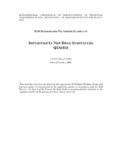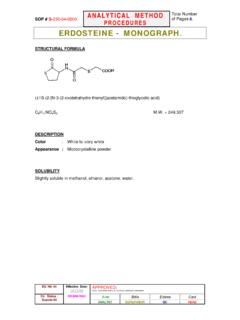Transcription of M7 (R1) Step 5 Assessment and control of DNA …
1 30 Churchill Place Canary Wharf London E14 5EU United Kingdom An agency of the European Union Telephone +44 (0)20 3660 6000 Facsimile +44 (0)20 3660 5555 Send a question via our website European Medicines Agency, 2017. Reproduction is authorised provided the source is acknowledged. 25 August 2015 EMA/CHMP/ICH/83812/2013 Committee for Human Medicinal Products ICH guideline M7(R1) on Assessment and control of DNA reactive (mutagenic) impurities in pharmaceuticals to limit potential carcinogenic risk Step 5 Transmission to CHMP July 2017 Adoption by CHMP for release for consultation July 2017 End of consultation (deadline for comments) January 2018 Final adoption by CHMP February 2018 Date for coming into effect February 2018 ICH guideline M7(R1) on Assessment and control of DNA reactive (mutagenic) impurities in pharmaceuticals to limit potential carcinogenic risk EMA/CHMP/ICH/83812/2013 Page 2/110 M7(R1) Document History Code History Date M7 Approval by the Steering Committee under Step 2 and release for public consultation.
2 6 February 2013 M7 Approval by the Steering Committee under Step 4 and recommendation for adoption to the three ICH regulatory bodies. 5 June 2014 M7 Corrigendum to fix typographical errors and replace word degradants with degradation products . 23 June 2014 M7(R1) Addendum Endorsement by the Members of the ICH Assembly under Step 2 and release for public consultation. 11 June 2015 Current Step 4 version M7(R1) Addendum Adoption by the Regulatory Members of the ICH Assembly under Step 4 and recommendation for adoption to the ICH regulatory bodies TBC ICH guideline M7(R1) on Assessment and control of DNA reactive (mutagenic) impurities in pharmaceuticals to limit potential carcinogenic risk EMA/CHMP/ICH/83812/2013 Page 3/110 ICH guideline M7(R1) on Assessment and control of DNA reactive (mutagenic) impurities in pharmaceuticals to limit potential carcinogenic risk Table of contents 1. Introduction .. 5 2. Scope of guideline.
3 5 3. General principles .. 6 4. Considerations for marketed products .. 7 Post approval changes to the drug substance chemistry, manufacturing, and controls .. 7 Post approval changes to the drug product chemistry, manufacturing, and controls .. 7 Changes to the clinical use of marketed products .. 8 Other considerations for marketed 8 5. Drug substance and drug product impurity Assessment .. 8 Synthetic impurities .. 8 Degradation 9 Considerations for clinical development .. 9 6. Hazard Assessment elements .. 10 7. Risk characterization .. 11 TTC-based acceptable intakes .. 11 Acceptable intakes based on compound-specific risk assessments .. 11 Mutagenic impurities with positive carcinogenicity data (class 1 in table 1) .. 11 Mutagenic impurities with evidence for a practical threshold .. 12 Acceptable intakes in relation to less-than-lifetime (LTL) exposure .. 12 Clinical development.
4 12 Marketed products .. 13 Acceptable intakes for multiple mutagenic impurities .. 13 Exceptions and flexibility in approaches .. 13 8. control .. 14 control of process related impurities .. 14 Considerations for control approaches .. 16 Considerations for periodic testing .. 16 control of degradation products .. 16 Lifecycle management .. 17 Considerations for clinical development .. 18 9. Documentation .. 18 Clinical trial applications .. 18 Common technical document (marketing application) .. 18 ICH guideline M7(R1) on Assessment and control of DNA reactive (mutagenic) impurities in pharmaceuticals to limit potential carcinogenic risk EMA/CHMP/ICH/83812/2013 Page 4/110 Glossary .. 24 References .. 26 Appendices .. 27 Appendix 1: Scope scenarios for application of the ICH M7 guideline .. 27 Appendix 2: Case examples to illustrate potential control approaches .. 28 Appendix 3: Addendum to ICH M7.
5 32 ICH guideline M7(R1) on Assessment and control of DNA reactive (mutagenic) impurities in pharmaceuticals to limit potential carcinogenic risk EMA/CHMP/ICH/83812/2013 Page 5/110 1. Introduction The synthesis of drug substances involves the use of reactive chemicals, reagents, solvents, catalysts, and other processing aids. As a result of chemical synthesis or subsequent degradation, impurities reside in all drug substances and associated drug products. While ICH Q3A(R2): impurities in New Drug Substances and Q3B(R2): impurities in New Drug Products (Ref. 1, 2) provides guidance for qualification and control for the majority of the impurities , limited guidance is provided for those impurities that are DNA reactive. The purpose of this guideline is to provide a practical framework that is applicable to the identification, categorization, qualification, and control of these mutagenic impurities to limit potential carcinogenic risk.
6 This guideline is intended to complement ICH Q3A(R2), Q3B(R2) (Note 1), and ICH M3(R2): Nonclinical Safety Studies for the Conduct of Human Clinical Trials and Marketing Authorizations for Pharmaceuticals (Ref. 3). This guideline emphasizes considerations of both safety and quality risk management in establishing levels of mutagenic impurities that are expected to pose negligible carcinogenic risk. It outlines recommendations for Assessment and control of mutagenic impurities that reside or are reasonably expected to reside in final drug substance or product, taking into consideration the intended conditions of human use. 2. Scope of guideline This document is intended to provide guidance for new drug substances and new drug products during their clinical development and subsequent applications for marketing. It also applies to post-approval submissions of marketed products, and to new marketing applications for products with a drug substance that is present in a previously approved product, in both cases only where: Changes to the drug substance synthesis result in new impurities or increased acceptance criteria for existing impurities ; Changes in the formulation, composition or manufacturing process result in new degradation products or increased acceptance criteria for existing degradation products; Changes in indication or dosing regimen are made which significantly affect the acceptable cancer risk level.
7 Assessment of the mutagenic potential of impurities as described in this guideline is not intended for the following types of drug substances and drug products: biological/biotechnological, peptide, oligonucleotide, radiopharmaceutical, fermentation products, herbal products, and crude products of animal or plant origin. This guideline does not apply to drug substances and drug products intended for advanced cancer indications as defined in the scope of ICH S9 (Ref. 4). Additionally, there may be some cases where a drug substance intended for other indications is itself genotoxic at therapeutic concentrations and may be expected to be associated with an increased cancer risk. Exposure to a mutagenic impurity in these cases would not significantly add to the cancer risk of the drug substance. Therefore, impurities could be controlled at acceptable levels for non-mutagenic impurities . Assessment of the mutagenic potential of impurities as described in this guideline is not intended for excipients used in existing marketed products, flavoring agents, colorants, and perfumes.
8 Application of this guideline to leachables associated with drug product packaging is not intended, but the safety risk Assessment principles outlined in this guideline for limiting potential carcinogenic risk can be used if warranted. The safety risk Assessment principles of this guideline can be used if warranted for ICH guideline M7(R1) on Assessment and control of DNA reactive (mutagenic) impurities in pharmaceuticals to limit potential carcinogenic risk EMA/CHMP/ICH/83812/2013 Page 6/110 impurities in excipients that are used for the first time in a drug product and are chemically synthesized. 3. General principles The focus of this guideline is on DNA reactive substances that have a potential to directly cause DNA damage when present at low levels leading to mutations and therefore, potentially causing cancer. This type of mutagenic carcinogen is usually detected in a bacterial reverse mutation (mutagenicity) assay.
9 Other types of genotoxicants that are non-mutagenic typically have threshold mechanisms and usually do not pose carcinogenic risk in humans at the level ordinarily present as impurities . Therefore to limit a possible human cancer risk associated with the exposure to potentially mutagenic impurities , the bacterial mutagenicity assay is used to assess the mutagenic potential and the need for controls. Structure-based assessments are useful for predicting bacterial mutagenicity outcomes based upon the established knowledge. There are a variety of approaches to conduct this evaluation including a review of the available literature, and/or computational toxicology Assessment . A Threshold of Toxicological Concern (TTC) concept was developed to define an acceptable intake for any unstudied chemical that poses a negligible risk of carcinogenicity or other toxic effects. The methods upon which the TTC is based are generally considered to be very conservative since they involve a simple linear extrapolation from the dose giving a 50% tumor incidence (TD50) to a 1 in 106 incidence, using TD50 data for the most sensitive species and most sensitive site of tumor induction.
10 For application of a TTC in the Assessment of acceptable limits of mutagenic impurities in drug substances and drug products, a value of g/day corresponding to a theoretical 10-5 excess lifetime risk of cancer, can be justified. Some structural groups were identified to be of such high potency that intakes even below the TTC would theoretically be associated with a potential for a significant carcinogenic risk. This group of high potency mutagenic carcinogens referred to as the cohort of concern , comprises aflatoxin-like-, N-nitroso-, and alkyl-azoxy compounds. During clinical development, it is expected that control strategies and approaches will be less developed in earlier phases where overall development experience is limited. This guideline bases acceptable intakes for mutagenic impurities on established risk Assessment strategies. Acceptable risk during the early development phase is set at a theoretically calculated level of approximately one additional cancer per million.















